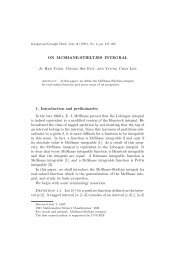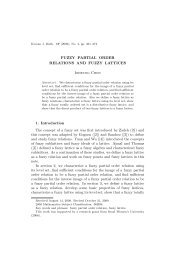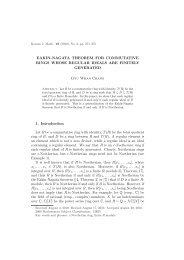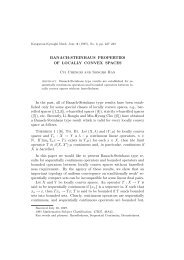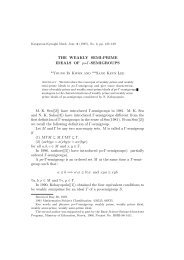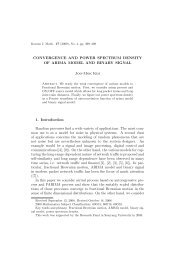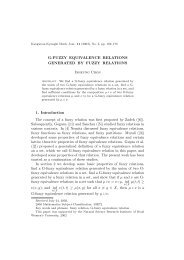ϵ-FUZZY EQUIVALENCE RELATIONS Inheung Chon 1 ...
ϵ-FUZZY EQUIVALENCE RELATIONS Inheung Chon 1 ...
ϵ-FUZZY EQUIVALENCE RELATIONS Inheung Chon 1 ...
Create successful ePaper yourself
Turn your PDF publications into a flip-book with our unique Google optimized e-Paper software.
74 <strong>Inheung</strong> <strong>Chon</strong>Proof. It is clear that µ ∩ ν is ɛ-reflexive and symmetric. ByProposition 2.7, [(µ ∩ ν) ◦ (µ ∩ ν)] ⊆ [µ ◦ (µ ∩ ν)] ∩ [ν ◦ (µ ∩ ν)] ⊆[(µ◦µ)∩(µ◦ν)]∩[(ν◦µ)∩(ν◦ν)] ⊆ [µ∩(µ◦ν)]∩[(ν◦µ)∩ν] ⊆ µ∩ν. Thatis, µ ∩ ν is transitive. Thus µ ∩ ν is an ɛ-fuzzy equivalence relation. □It is easy to see that even though µ and ν are ɛ-fuzzy equivalencerelations, µ ∪ ν is not necessarily an ɛ-fuzzy equivalence relation. Wefind the ɛ-fuzzy equivalence relation generated by µ ∪ ν on a set in thefollowing proposition.Proposition 3.2. Let µ and ν be ɛ-fuzzy equivalence relationson a set S. Then the ɛ-fuzzy equivalence relation generated by µ ∪ νin S is ∪ ∞ n=1(µ ∪ ν) n = (µ ∪ ν) ∪ [(µ ∪ ν) ◦ (µ ∪ ν)] ∪ . . . .Proof. Clearly (µ∪ν)(x, x) ≥ ɛ > 0. That is, µ∪ν is ɛ-reflexive. ByProposition 2.6, ∪ ∞ n=1(µ∪ν) n is ɛ-reflexive. Clearly µ∪ν is symmetric.By Proposition 2.5, ∪ ∞ n=1(µ ∪ ν) n is symmetric. By Proposition 2.4,∪ ∞ n=1(µ∪ν) n is transitive. Hence ∪ ∞ n=1(µ∪ν) n is an ɛ-fuzzy equivalencerelation containing µ ∪ ν. Let λ be an ɛ-fuzzy equivalence relation in Scontaining µ ∪ ν. Then ∪ ∞ n=1(µ ∪ ν) n ⊆ ∪ ∞ n=1λ n = λ ∪ (λ ◦ λ) ∪ (λ ◦ λ ◦λ) ∪ · · · ⊆ λ ∪ λ ∪ · · · = λ. Thus ∪ ∞ n=1(µ ∪ ν) n is the ɛ-fuzzy equivalencerelation generated by µ ∪ ν.□Theorem 3.3. Let µ and ν be ɛ-fuzzy equivalence relations on aset S such that µ(x, x) ≥ ν(x, y) and ν(y, y) ≥ µ(x, y) for all x, y ∈ S.If µ ◦ ν = ν ◦ µ, then µ ◦ ν is the ɛ-fuzzy equivalence relation on Sgenerated by µ ∪ ν.Proof.(µ◦ν)(x, x) = sup min [µ(x, z), ν(z, x)] ≥ min (µ(x, x), ν(x, x)) ≥ ɛ > 0z∈Sfor all x ∈ S. That is, µ ◦ ν is ɛ-reflexive. Since µ and ν are symmetric,(µ ◦ ν) −1 = ν −1 ◦ µ −1 = ν ◦ µ = µ ◦ ν. Thus µ ◦ ν issymmetric. Since µ and ν are transitive and the operation ◦ is associative,(µ ◦ ν) ◦ (µ ◦ ν) = µ ◦ (ν ◦ µ) ◦ ν = µ ◦ (µ ◦ ν) ◦ ν =(µ ◦ µ) ◦ (ν ◦ ν) ⊆ µ ◦ ν. Hence µ ◦ ν is an ɛ-fuzzy equivalence relation.Since ν(y, y) ≥ µ(x, y), (µ ◦ ν)(x, y) = sup min[µ(x, z), ν(z, y)] ≥z∈Smin(µ(x, y), ν(y, y)) = µ(x, y). Since µ(x, x) ≥ ν(x, y), (µ ◦ ν)(x, y) =supz∈Smin [µ(x, z), ν(z, y)] ≥ min (µ(x, x), ν(x, y)) = ν(x, y).Thus
ɛ-fuzzy equivalence relations 75(µ ◦ ν)(x, y) ≥ max (µ(x, y), ν(x, y)) = (µ ∪ ν)(x, y) for all x, y ∈ S.Thus µ ∪ ν ⊆ µ ◦ ν. Let λ be an ɛ-fuzzy equivalence relation in S containingµ ∪ ν. Since λ is transitive, µ ◦ ν ⊆ (µ ∪ ν) ◦ (µ ∪ ν) ⊆ λ ◦ λ ⊆ λ.Thus µ ◦ ν is the ɛ-fuzzy equivalence relation generated by µ ∪ ν. □Theorem 3.4. Let µ be a fuzzy relation on a set S. Then theɛ-fuzzy equivalence relation generated by µ in S is ∪ ∞ n=1(µ ∪ µ −1 ∪ θ) n ,where θ is a fuzzy relation in S such that θ(a, a) = ɛ for all a ∈ S andθ(x, y) = θ(y, x) ≤ min [µ(x, y), µ(y, x)] for all x, y ∈ S with x ≠ y.Proof. (µ ∪ µ −1 ∪ θ)(a, a) ≥ θ(a, a) = ɛ > 0 for all a ∈ S.Thus µ ∪ µ −1 ∪ θ is ɛ-reflexive. Let µ 1 = µ ∪ µ −1 ∪ θ. By Proposition2.6, ∪ ∞ n=1µ n 1 is ɛ-reflexive. µ 1 (x, y) = (µ ∪ µ −1 ∪ θ)(x, y) =max[µ(x, y), µ −1 (x, y), θ(x, y)] = max[µ −1 (y, x), µ(y, x), θ(y, x)]= (µ∪µ −1 ∪θ)(y, x) = µ 1 (y, x). Thus µ 1 is symmetric. By Proposition2.5, ∪ ∞ n=1µ n 1 is symmetric. By Proposition 2.4, ∪ ∞ n=1µ n 1 is transitive.Hence ∪ ∞ n=1µ n 1 is an ɛ-fuzzy equivalence relation containing µ. Let ν bean ɛ-fuzzy equivalence relation containing µ. Then µ(x, y) ≤ ν(x, y),µ −1 (x, y) = µ(y, x) ≤ ν(y, x) = ν(x, y), and θ(x, y) ≤ µ(x, y) ≤ ν(x, y)for all x, y ∈ S such that x ≠ y. That is, ν(x, y) ≥ (µ ∪ µ −1 ∪ θ)(x, y)for all x, y ∈ S such that x ≠ y. ν(a, a) ≥ µ(a, a) = µ −1 (a, a)for all a ∈ S. Since θ(a, a) = ɛ and ν(a, a) ≥ ɛ for all a ∈ S,θ(a, a) ≤ ν(a, a). That is, µ 1 (a, a) ≤ ν(a, a) for all a ∈ S. Thus µ 1 =(µ∪µ −1 ∪θ) ⊆ ν. Suppose µ k 1 ⊆ ν. Then µ k+11 (x, y) = (µ k 1 ◦µ 1 )(x, y) =supz∈Smin[µ k 1(x, z), µ 1 (z, y)] ≤ supz∈Smin[ν(x, z), ν(z, y)] = (ν ◦ ν)(x, y).Since ν is transitive, µ k+11 ⊆ ν ◦ ν ⊆ ν. By the mathematical induction,µ n 1 ⊆ ν for n = 1, 2 . . . . Hence ∪ ∞ n=1 µ n 1 = µ 1 ∪ (µ 1 ◦ µ 1 ) ∪ (µ 1 ◦µ 1 ◦ µ 1 ) · · · ⊆ ν. □4. Partitions of ɛ-fuzzy equivalence relationsMurali([3]) studied partition of fuzzy equivalence relations. Inthis section we define a fuzzy partition based on ɛ-fuzzy equivalencerelations and construct a fuzzy partition, which may be considered asa generalization of Murali’s work.Definition 4.1. Let µ be an ɛ-fuzzy equivalence relation on a
76 <strong>Inheung</strong> <strong>Chon</strong>set X. For 0 < p ≤ ɛ, a relation ≺ p on X is defined by x ≺ p y iffµ(x, y) ≥ p.Proposition 4.2. Let µ be an ɛ-fuzzy equivalence relation on aset X. Then the relation ≺ p on a set X defined in Definition 4.1 is anequivalence relation.Proof. Since µ(x, x) ≥ ɛ ≥ p, ≺ p is reflexive. Suppose x ≺ p y.Then µ(x, y) ≥ p, and hence µ(y, x) ≥ p. Thus ≺ p is symmetric. Supposex ≺ p y and y ≺ p z. Then µ(x, y) ≥ p and µ(y, z) ≥ p. µ(x, z) =(µ ◦ µ)(x, z) = sup min(µ(x, k), µ(k, z)) ≥k∈Xmin(µ(x, y), µ(y, z)) ≥ p. Thus ≺ p is transitive.□Definition 4.3. Let µ be an ɛ-fuzzy equivalence relation on a setX and let ≺ p be an equivalence relation on X defined in Proposition4.2. The equivalence class containing x is denoted by [x] p . That is,[x] p = {y ∈ X : y ≺ p x} for p ≤ ɛ.Definition 4.4. Let µ be an ɛ-fuzzy equivalence relation on a setX and let ≺ p be an equivalence relation on X defined in Proposition4.2. A fuzzy subset µ [x]ɛ on a set X is defined by µ [x]ɛ (y) = µ(x, y).Definition 4.5. Let {ν i : ∈ I} be a collection of fuzzy sets on aset X. If (∪ i∈I ν i )(z) ≥ p and ν i ∩ ν j = 0 for all i, j ∈ I with i ≠ j,we call {ν i : i ∈ I} is a fuzzy partition of a fuzzy set χ p Xon X, whereχ p X : X → R is a function defined by χp X(x) ≥ p for all x ∈ X.Lemma 4.6. Let µ be an ɛ-fuzzy equivalence relation on a set X.Then [x] p ∩ [y] p = ∅ for some 0 < p ≤ ɛ iff (µ [x]ɛ ∩ µ [y]ɛ )(z) = 0 for allz ∈ X.Proof. (→) Suppose (µ [x]ɛ ∩ µ [y]ɛ )(z) > 0 for some z ∈ X. Thenµ [x]ɛ (z) ≥ p and µ [y]ɛ (z) ≥ p for some p ≤ ɛ. That is, µ(x, z) ≥ p andµ(y, z) ≥ p. Thus µ(x, y) ≥ (µ◦µ)(x, y) = sup min(µ(x, k), µ(k, y)) ≥k∈Xmin(µ(x, z), µ(y, z)) ≥ p. That is, x ≺ p y. This contradicts [x] p ∩[y] p =∅.(→) Suppose α ∈ [x] p ∩ [y] p . Then x ≺ p α and y ≺ p α. Since ≺ p isan equivalence relation by Proposition 4.2, x ≺ p y. Thus µ(x, y) ≥ p.Since µ(y, y) ≥ ɛ and p ≤ ɛ, (µ [x]ɛ ∩ µ [y]ɛ )(y) = min(µ(x, y), µ(y, y)) ≥p. This contradicts that (µ [x]ɛ ∩ µ [y]ɛ )(z) = 0 for all z ∈ X. □
ɛ-fuzzy equivalence relations 77Theorem 4.7. Let µ be an ɛ-fuzzy equivalence relation on a setX. Let {[x i ] p : x i ∈ X, i ∈ I} be a partition of X. Then {µ [xi ] ɛ: x i ∈X, i ∈ I} is a fuzzy partition of a fuzzy set χ p Xon X.Proof. Let i, j ∈ I with i ≠ j. Then [x i ] p ∩ [x j ] p = ∅. By Lemma4.6, (µ [xi ] ɛ∩ µ [xj ] ɛ)(z) = 0 for all z ∈ X. Let y ∈ X. Then y ∈ [x k ] pfor some k ∈ I. Since y ≺ p x k , µ(y, x k ) ≥ p. Thus(∪ i∈I µ [xi ] ɛ)(y) = sup i∈I µ [xi ] ɛ(y) = sup i∈I µ(x i , y ) = µ(x k , y) ≥ p.□References1. J. A. Goguen, L-fuzzy sets, J. Math. Anal. Appl. 18 (1967), 145–174.2. K. C. Gupta and R. K. Gupta, Fuzzy equivalence relation redefined, Fuzzy Setsand Systems 79 (1996), 227–233.3. V. Murali, Fuzzy equivalence relation, Fuzzy Sets and Systems 30 (1989), 155–163.4. C. Nemitz, Fuzzy relations and fuzzy function, Fuzzy Sets and Systems 19(1986), 177–191.5. E. Sanchez, Resolution of composite fuzzy relation equation, Inform. and Control30 (1976), 38–48.6. R. T. Yeh, Toward an algebraic theory of fuzzy relational systems, Proc. Int.Congr. Cybern. (1973), 205–223.7. L. A. Zadeh, Fuzzy sets, Inform. and Control 8 (1965), 338–353.Department of MathematicsSeoul Women’s UniversitySeoul, 139–774, KoreaE-mail: ihchon@swu.ac.kr


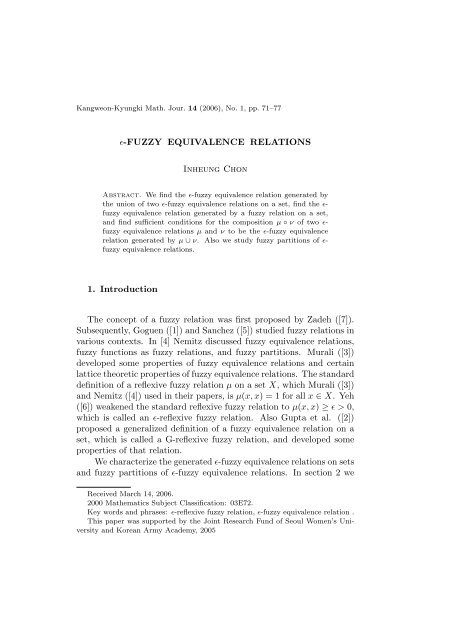
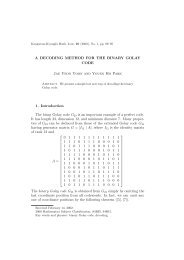
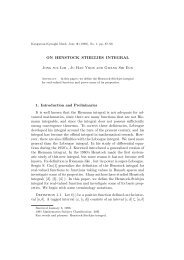
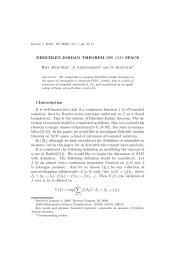

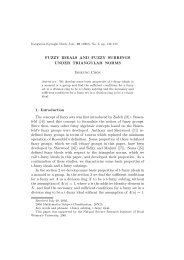
![SEMI-REGULAR po-SEMIGROUPS SK Lee J. Calais([1])](https://img.yumpu.com/46211509/1/184x260/semi-regular-po-semigroups-sk-lee-j-calais1.jpg?quality=85)
